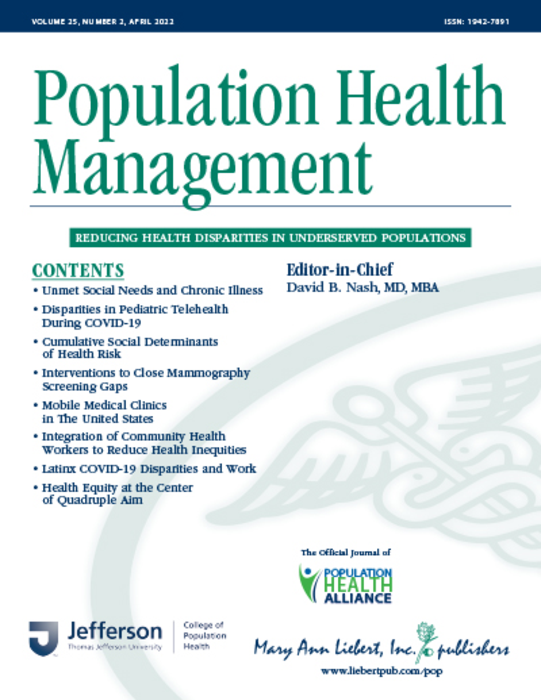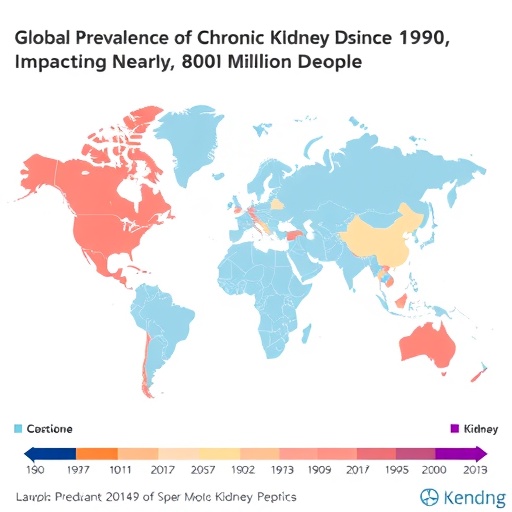Continuing telehealth care delivery beyond the COVID-19 pandemic will benefit publicly insured children if they are ensured equitable access to telehealth services. This study finding is part of a Special Issue on “Reducing Health Disparities in Underserved Populations” in the peer-reviewed journal Population Health Management. Click here to read the issue now.

Credit: Mary Ann Liebert, Inc., publishers
Continuing telehealth care delivery beyond the COVID-19 pandemic will benefit publicly insured children if they are ensured equitable access to telehealth services. This study finding is part of a Special Issue on “Reducing Health Disparities in Underserved Populations” in the peer-reviewed journal Population Health Management. Click here to read the issue now.
In their article, Bisakha Sen, PhD, from the University of Alabama at Birmingham, and coauthors, examined disparities in telehealth utilization in a population of publicly insured children. They found evidence of disparities in telehealth use by race/ethnicity, rurality, and family income. “Those in the highest family income-based fee group had higher odds of telehealth use than the lowest family income-based fee group,” stated the authors. “As telehealth will likely continue to play an important role in health care delivery, additional efforts/investments are required to ensure telehealth does not further exacerbate inequities in pediatric health care access.”
Also in this issue is the article titled “Mobile Medical Clinics in the United States Post-Affordable Care Act: An Integrative Review” by Angela Coaston, PhD, RN, from the University of California San Francisco, School of Nursing, and coauthors. They found that mobile medical clinics “provide a return on investment through emergency room avoidance, decreasing hospital length of stay and improving chronic disease management.” They concluded that “As the importance of social determinants of health and community-clinical connections are recognized, mobile medical clinics are positioned to inform policy, to improve chronic disease health outcomes, and to advance health equity among vulnerable populations.”
In the article titled “A Tale of Four Babies: Health Equity at the Center of the Quadruple Aim,” J. Nwando Olayiwola, MD, MPH, Chief Health Equity Officer and Senior Vice President at Humana, Inc. observes that communities of color were the hardest hit by the COVID-19 pandemic. She examines the foundational roots of this inequity, “specifically the entrenched structural racism that shapes the policies that ultimately shape the health outcomes.” She also provides a historical perspective on racism in American health care. She points to the Quadruple Aim as having become the gold standard in health care: “prioritizing patient experience, reducing costs, addressing population health, and tending to the providers that deliver that care.”
“No single citizen can receive high quality care until we all can! This special issue brings together the top thought leaders from across the nation to tackle one of the biggest challenges in our industry. At the core of a just society is our ability to reduce inequality in health care,” says David Nash, MD, MBA, Editor-in-Chief of Population Health Management and Founding Dean Emeritus and Dr. Raymond C. and Doris N. Grandon Professor, Jefferson College of Population Health, Philadelphia, PA.
About the Journal
Population Health Management is an authoritative peer-reviewed journal published bimonthly in print and online that reflects the expanding scope of health care management and quality. The Journal delivers a comprehensive, integrated approach to the field of population health and provides information designed to improve the systems and policies that affect health care quality, access, and outcomes. Comprised of peer-reviewed original research papers, clinical research, and case studies, the content encompasses a broad range of chronic diseases (such as cardiovascular disease, cancer, chronic pain, diabetes, depression, and obesity) in addition to focusing on various aspects of prevention and wellness. Tables of Contents and a sample issue may be viewed on the Population Health Management website. Population Health Management is the official journal of the Population Health Alliance.
About the Publisher
Mary Ann Liebert, Inc., publishers is known for establishing authoritative peer-reviewed journals in many promising areas of science and biomedical research. A complete list of the firm’s more than 100 journals, books, and newsmagazines is available on the Mary Ann Liebert, Inc., publishers website.
Journal
Population Health Management
DOI
10.1089/pop.2022.0027
Method of Research
Case study
Subject of Research
People
Article Title
Reducing health disparities in underserved populations: A spotlight on health inequities




